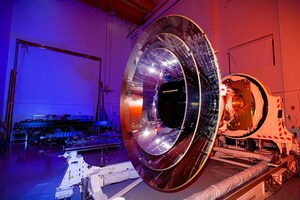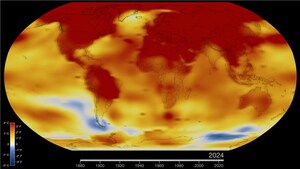WASHINGTON, July 16, 2015 /PRNewswire-USNewswire/ -- U.S. firefighters battling wildfires this year will get a clearer view of these threats with new NASA-funded satellite-based tools to better detect fires nationwide and predict their behavior.
The new fire detection tool now in operation at the U.S. Department of Agriculture (USDA) Forest Service (USFS) uses data from the Suomi National Polar-orbiting Partnership (NPP) satellite to detect smaller fires in more detail than previous space-based products. The high-resolution data have been used with a cutting-edge computer model to predict how a fire will change direction based on weather and land conditions.
This tool is another example of the high-value benefits from cooperative efforts between NASA and the USDA, the future of which was formalized Thursday when NASA Deputy Administrator Dava Newman and USDA Deputy Secretary Krysta Harden signed an agreement that establishes a framework for future enhanced cooperation in the areas of Earth science research, technology, agricultural management, and the application of science data, models and technology in agricultural decision-making.
The new active fire detection product using data from Suomi NPP's Visible Infrared Imaging Radiometer Suite (VIIRS) increases the resolution of fire observations to 1,230 feet (375 meters). Previous NASA satellite data products available since the early 2000s observed fires at 3,280 foot (1 kilometer) resolution. The jump in detail is helping transform how satellite remote sensing data are used in support of wildfire management.
The data are one of the intelligence tools used by the USFS and Department of Interior agencies across the United States to guide resource allocation and strategic fire management decisions.
"The high-resolution data gleaned from VIIRS are available in a short time period and significantly enhances the Forest Service's current strategic fire detection and monitoring capabilities," said Brad Quayle, program lead at the USFS Remote Sensing Applications Center in Salt Lake City. "They are welcomed by the end users we serve in the interagency wildfire management community."
Compared to its predecessors, the enhanced VIIRS fire product enables detection every 12 hours or less of much smaller fires and provides more detail and consistent tracking of fire lines during long duration wildfires – capabilities critical for early warning systems and support of routine mapping of fire progression. Active fire locations are available to users within minutes from the satellite overpass through data processing facilities at the USFS Remote Sensing Applications Center, which uses technologies developed by the NASA Goddard Space Flight Center Direct Readout Laboratory in Greenbelt, Maryland.
The new VIIRS 375m fire detection product was developed with support from NASA's Earth Science Applied Sciences Program, the National Oceanic and Atmospheric Administration (NOAA) Joint Polar Satellite System Proving Ground Program, and the U.S. Forest Service. The project team was led by Wilfrid Schroeder at the University of Maryland College Park with scientists at the National Center for Atmospheric Research (NCAR), Boulder, Colorado.
NCAR developed a new cutting-edge weather-fire model that has demonstrated potential to enhance firefighter and public safety by increasing awareness of rapidly changing fire behavior. The model uses data on weather conditions and the land surrounding an active fire to predict 12-18 hours in advance whether a blaze will shift direction. The VIIRS fire detection product has been applied to these models, successfully verifying the wildfire simulations.
The state of Colorado recently decided to incorporate the weather-fire model in its firefighting efforts beginning with the 2016 fire season.
"We hope that by infusing these higher resolution detection data and fire behavior modeling outputs into tactical fire situations, we can lessen the pressure on those working in fire management," said Schroeder.
In 2014, an international field campaign was organized in South Africa's Kruger National Park to validate fire detection products including the new VIIRS active fire data. In advance of that campaign, the Meraka Institute of the Council for Scientific and Industrial Research in Pretoria, South Africa, an early adopter of the VIIRS 375m fire product, put it to use during several large wildfires in Kruger.
"We had some serious wildfires in September 2014, and the VIIRS 375-meter data performed excellently," said Philip Frost of the Meraka Institute.
The demand for timely, high-quality fire information has increased in recent years. Wildfires in the United States burn an average of 7 million acres of land each year. For the last 10 years, the USFS and Department of Interior have spent a combined average of about $1.5 billion annually on wildfire suppression. Large catastrophic wildfires have become commonplace, especially in association with extended drought and extreme weather.
NASA's expertise in space and scientific exploration contributes to essential services provided to the American people by other federal agencies, such as natural resource management and weather forecasting. Suomi NPP is a joint mission of NASA and NOAA launched in 2011.
The multispectral imaging capabilities of the Suomi NPP VIIRS instrument support atmospheric studies and a variety of operational products including imaging of hurricanes, sea surface temperature, sea ice, landscapes, and the detection of fires, smoke and atmospheric aerosols.
NASA uses the vantage point of space to increase our understanding of our home planet, improve lives, and safeguard our future. NASA develops new ways to observe and study Earth's interconnected natural systems with long-term data records. The agency freely shares this unique knowledge and works with institutions around the world to gain new insights into how our planet is changing.
Active fire maps of the United States are available online at:
http://activefiremaps.fs.fed.us
For more information on how NASA Earth science aids people, visit:
http://go.nasa.gov/earthbenefits
Logo - http://photos.prnewswire.com/prnh/20081007/38461LOGO
SOURCE NASA
Related Links
WANT YOUR COMPANY'S NEWS FEATURED ON PRNEWSWIRE.COM?
Newsrooms &
Influencers
Digital Media
Outlets
Journalists
Opted In





Share this article